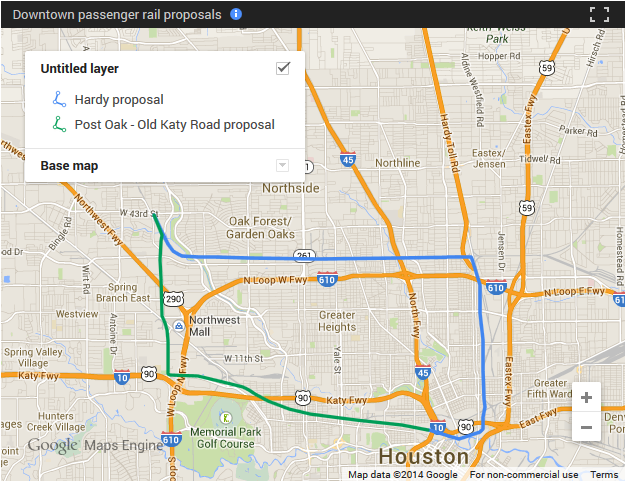From The Highwayman:
As has been reported, the Gulf Coast Rail District is studying the best possible routes for commuter rail in the Houston area, and one of the biggest challenges is bringing the trains into downtown. From the looks of the initial analysis of the U.S. 290 corridor, the trip to the central business district might have some unexpected stops along the way.
Relying on potentially available right of way, the analysis conducted by Kimley Horn & Associates found that the two most feasible routes from a hypothetical train station at 43rd Street and Mangum Road would largely rely on land next to existing freight rail lines, heading east, then south, or south, then east. The study involved finding a route where land would be potentially available without obstacles like buildings. Those who did the study also were tasked with avoiding flood-prone areas, environmental impacts and technical challenges. Officials also had to avoid affecting the major freight railroads, said Maureen Crocker, executive director of the rail district.
One scenario would send the line eastward parallel to the BNSF Railway tracks, then south along land near where Harris County plans to extend the Hardy Toll Road inside Loop 610. From there, the trains would briefly use space next to the Union Pacific Railroad’s main line, into the Amtrak station near the downtown U.S. Post Office.
The other option would bring the trains south along Mangum Road and Post Oak Boulevard before heading east along Katy Road and then parallel to the Union Pacific tracks north of Washington Avenue and into downtown.
[…]
Commuter rail — not the light rail system that Metropolitan Transit Authority has built — would bring travelers from much longer distances than light rail would, connecting areas far outside the Sam Houston Tollway. If Houston ever developed a robust regional passenger rail system, Lott said, the potential northwest station could be the hub of up to eight rail lines, coming from as far as 100 miles away.
The addition of passenger trains could also revitalize the downtown Amtrak station, which only serves a handful of passenger trains each week. In other cities where transit and train service has led to increased traffic, train stations are experiencing a renaissance.
See here for the background. This conversation has come up before, most recently as I recall about a decade ago when one of the options was to bring the line through the Heights, along the former rail right of way that is now the White Oak bike trail. Needless to say, that’s not on the table. You can see the presentation with all of the routes that were considered this time at the link above. I don’t know much about the northern path that would go to the Hardy Toll Road right of way, but the Katy Road/MKT option would basically run along one possible path for the Inner Katy light rail line, if it ever gets onto a drawing board. It might make sense to build a station or two along the way for this configuration, given the population and employment locations along Washington Avenue. I just hope that if they do this, they consider doing something about the rail crossings at Durham/Shepherd, Heights, Sawyer, and Houston Avenue. Traffic gets snarled up enough with the infrequent freight train schedule; with commuter rail frequency it would be a nightmare, especially at Durham/Shepherd. I’m sure that will add another hundred million or two to the price tag, but come on. The need and the benefit are obvious.

